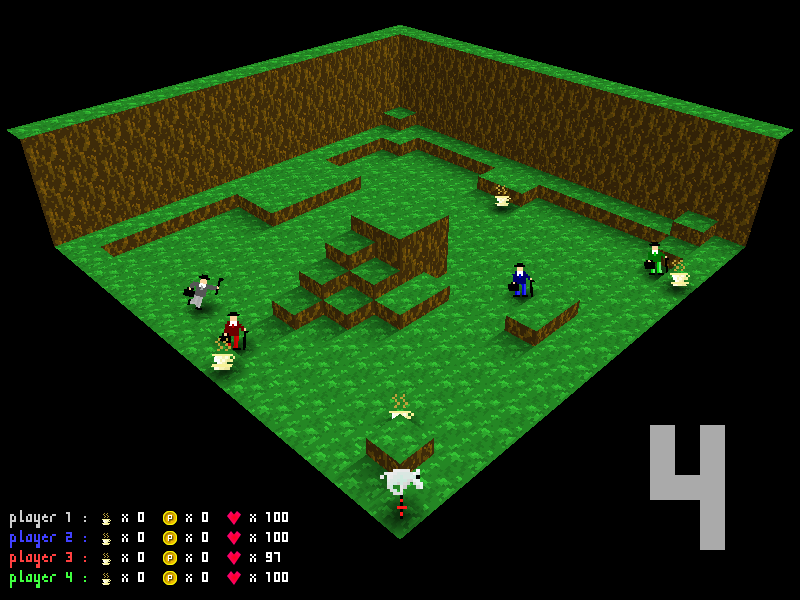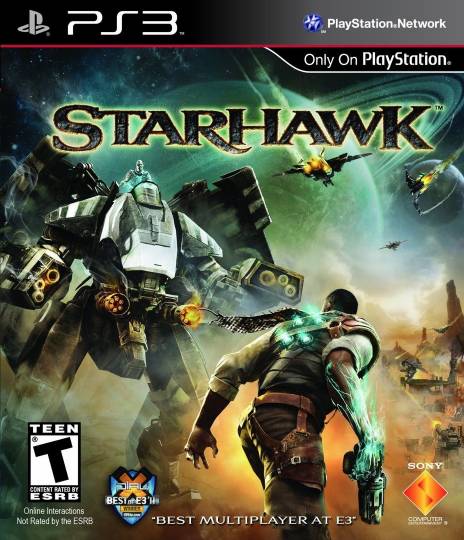
Back in late April, the No Fun Games gang (Renaud Bédard, Kira Boom, and I) took the train down to Toronto to participate in TOJam. Over three days, we hacked together a silly game called Tea Time Quarrel. Since then we’ve had the opportunity to present the game publicly at TOJam Arcade and the Mount Royal Game Society. However, we never got around to officially releasing it… until now!
 Download Tea Time Quarrel (Windows)
Download Tea Time Quarrel (Windows)
Though we’re quite proud of this little experimental game, our excitement for releasing it is tempered by the fact that the majority of players will not have the hardware peripherals necessary to play it. Tea Time Quarrel is a multiplayer game designed to be played with four game pads. There simply isn’t enough room on the keyboard to allow four players access to six keys each, and the limited scope of the game jam meant that we did not have time to implement a variable number of players.
Partly in light of this unfortunate restriction, I thought I’d write a little bit about how Tea Time Quarrel is played and what our design goals were in creating it.

The central idea behind Tea Time Quarrel occurred to me when I was reading an article about the fundamentals of game design (which I can no longer find, but may have been Jesper Juul’s “The Game, the Player, the World”). The article asserted that the rules of a game are agreed to by all players beforehand, and are fixed once the game begins. My inner contrarian balked at this statement; why couldn’t the rules of a game be defined dynamically1? Could the strategic creation and election of new rules be a second-order game mechanic?
The goal of Tea Time Quarrel is to be the first player to reach 100 points. Players can perform a modest variety of actions: jump, run around, collect teacups, attack goats2, attack other players, etc. However, none of these actions will inherently bring them any closer to a victory condition. Every twenty seconds one of the players is given the opportunity to propose a new rule. Rules follow a simple four-part syntax:
| Condition | Consequence | ||
| Each Most Least |
Mile Teacup Health Point Jump Kill |
Adds Removes |
Teacup Health Point Speed |
This may look complicated, but it’s quite simple in practice. For example, the rule “Each Teacup Adds Points” would give a player one point every time she collects a teacup. On the other hand, the rule “Least Jumps Removes Speed” would reduce the walking speed of the player who has jumped the fewest times overall at the end of each round. While the vocabulary seems rather limited, it can still produce 128 valid rule combinations3. Due to scoping and technical restrictions, it should be noted that the effects of rules do not currently trigger other rules.
Of course, proposing a rule is only half the story. A rule is only added to the game if a majority of players vote for it (“Democracy! Just as The Queen intended.”) This prevents players from designing rules that are blatantly in their favour. Instead, players must subtly seek the advantage while convincing other players to accept their new rule.

Whether you assemble enough peripherals to actually play the game or just have a good chuckle at the concept, we hope that you enjoy Tea Time Quarrel!

1 Of course the rules about making rules are fixed and agreed to beforehand, so this is just a layer of abstraction.
2 The “Goat on a Pole” is the TOJam mascot.
3 Rules with conditions of “Each Point” or “Each Health” can never be triggered, so they’re marked as invalid.





October 31st, 2010 at 8:29 pm
This idea reminds me of a card game I just learnt about a couple of weeks ago called ‘Mao’ (or any other host of names): http://en.wikipedia.org/wiki/Mao_(card_game)
Part of the rules of the game are that when you reenter the game you make a new rule. (Also I now have to draw a card for explaining the rules. =P)
October 31st, 2010 at 9:00 pm
Hi there,
I really like the look of the game – however, do you think it would be possible to create a version that allows for 2 players to play, one using keyboard and one using the gamepad? I don’t have 4 gamepads, but I still really want to try it out with 1 friend – obviously, however, we can’t do this as both the keys and my one controller move the same character!
October 31st, 2010 at 8:06 pm
Finally! Looking forward to playing it. (When I first heard of it, it reminded me of the card game Mao.)
October 31st, 2010 at 11:27 pm
@Mike: I had forgotten that we already have the second player debug controls mapped on the keyboard. IJKL for movement, G and H for attack and jump. Furthermore, you can make players 3 and 4 vote for rules with the 1-4 number keys. If you’re at all handy with scripting, you can change any of these controls in components/c.lua if you’d like. Hope this helps!
November 1st, 2010 at 8:57 am
[…] already wrote a super thorough write-up about it, so I won’t bother. But here’s the direct link to the game itself : Tea-Time […]
November 1st, 2010 at 9:51 am
No Mac version? No web version?
November 1st, 2010 at 7:47 pm
@Alex: We used a hand-rolled game engine (DokiDoki) to develop Tea Time Quarrel, which implies a certain level of deployment woe. In this case, the joystick support in GLFW isn’t currently working on OSX.
November 2nd, 2010 at 3:39 am
That’s all fine and dandy, but what about that MacOSX version of Pax Britannica?
November 2nd, 2010 at 5:58 pm
Trying to figure out the keymap was a pain.
“There simply isn’t enough room on the keyboard to allow four players
access to six keys each…”
With a limited laptop keyboard, controllers are another question:
grey: arrows ^Z X
blue: ijkl ^G H
red: 1— ^- 2
green: 3— ^- 4
red and green have access to up and enter allowing them to vote ya or nay.
The nature of the game was what I found amusing. Was hoping a wireless keyboard would allow the usage. Doesn’t look like the .lua files are easily remapped.
November 2nd, 2010 at 9:15 pm
@Barts: The OSX version of Pax Britannica is actually very nearly in the can. Unfortunately we’re having a few sound issues with the Linux version, and we’re hoping to release both simultaneously.
November 3rd, 2010 at 9:50 am
This looks great! I have an affinity for any digital game that incorporates house rules, and it’s very refreshing to see something like this where player defined rules are the focus.
If you guys make a sequel, consider giving the goats guns and having lots of bloom lighting.